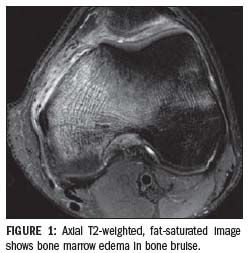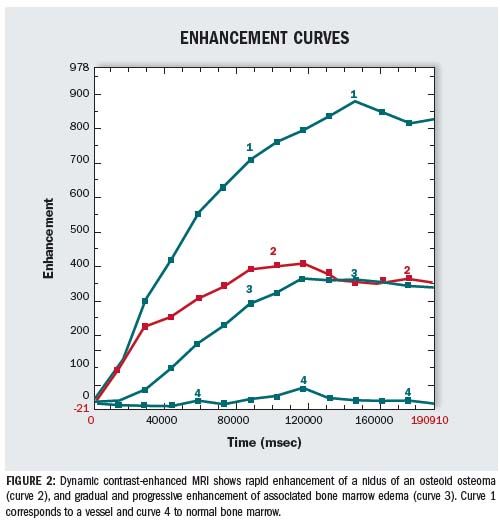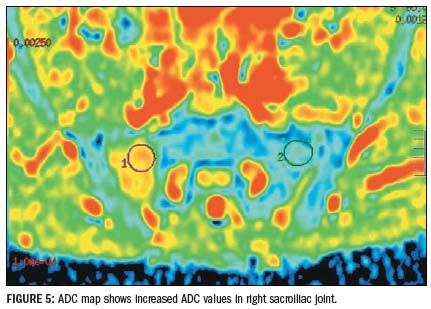Bone marrow edema aids diagnosis and prognosis
Bbone marrow edema is characterized by ill-defined areas of decreased signal intensity on T1-weighted MRI and increased signal intensity on T2-weighted images.
The term “bone marrow edema” was first introduced in 1988.1 It is characterized by ill-defined areas of decreased signal intensity on T1-weighted MRI and increased signal intensity on T2-weighted images.
Bone marrow edema is not the major component of histological anomalies in most situations. For this reason, some authors prefer “bone marrow edema-like” signal or abnormalities.2 Its physiopathology is unclear and varies with the underlying pathological condition.
Bone marrow edema may be apparent in a variety of anomalies that correspond to their etiologies (e.g., necrosis, fibrosis, hemorrhage, inflammation).
Cytokines play an important role in the formation of bone marrow edema. This could explain the link between bone marrow edema and pain, as well as the effect of treatments such as corticosteroids or anti-tumor-necrosis-factor-α (anti-TNFα) on the expression of cytokines. Peritumoral edema in bone tumors correlates with the level of prostaglandins and with the expression of cyclo-oxygenase-2, which is implicated in prostaglandin synthesis.3
SEQUENCE CHOICE
Although bone marrow edema is defined using classic MRI sequences, it is better characterized with complementary sequences.

Classic sequences: Bone marrow edema is characterized by ill-defined medullary infiltration without bone lysis. It appears hypointense on T1-weighted images and hyperintense on T2-weighted/fat-saturated or STIR images and enhanced after injection of gadolinium contrast (Figure 1). Analysis of the trabeculae requires good spatial resolution. Identification of bone marrow edema on T2-weighted MRI may be difficult in the absence of fat-saturation techniques.
In-phase/opposed-phase imaging:Voxel signal intensity typically approaches zero on opposed-phase images when edema is present in the yellow marrow, reflecting equivalence in the quantities of water and fat. The signal is increased on in-phase images. Signal intensity reduction on opposed-phase acquisitions is lower when a tumoral process has infiltrated the bone marrow, owing to the reduced fat levels. There is no clear-cut threshold, however, to distinguish between benign and malignant processes.
Dynamic contrast-enhanced MRI: Bone marrow edema is characterized by a gradual increase in enhancement, which can be analyzed quantitatively using the enhancement factor and the enhancement gradient. This information is important because bone marrow edema is a sensitive marker of inflammatory activity and of response to treatment for rheumatoid arthritis or spondyloarthropathies.4 The examination can also help distinguish bone tumors (osteoid osteoma) from surrounding edema (Figure 2).

Diffusion-weighted MRI: Most pathologic processes affecting the bone marrow lead to an increase in apparent diffusion coefficient (ADC) and T2 values and appear bright on diffusion-weighted MRI. The calculation of ADC eliminates the T2 effect from diffusion images and provides a quantifiable value that is directly proportional to the degree of diffusion of water (Figure 3). Although ADC values for bone marrow edema and tumor overlap, the ADC calculation could still be used to quantify bone marrow edema and for follow-up (Figures 4 and 5). While diffusion-weighted imaging can reveal increased ADC values, STIR and T1-weighted spin-echo images show the disappearance of the classic BME pattern.
In summary, classic T1-weighted spin-echo and T2-weighted fast spin-echo imaging with fat saturation (or STIR) are usually sufficient to detect and diagnose bone marrow edema. Injection of gadolinium-based contrast is indicated when looking for extra-osseous anomalies, such as synovitis, for the detection of small bony lesions that can be hidden by edema, or for edema quantification. Dynamic-contrast MRI should be performed in such cases. Diffusion-weighted MRI is a promising tool for the quantification and follow-up of bone marrow edema.
DIFFERENTIAL DIAGNOSIS
Bone tumors are usually easy to distinguish from edema. Tumors are usually characterized by heterogeneous signal intensity, clear borders, bone structure modification (sclerosis, lysis, specific matrix), or soft tissue invasion.
Hematopoeitic marrow hyperplasia represents a deviation from the accepted adult pattern of red-yellow marrow distribution. Located in the posterior part of the distal femoral metaphyses, it usually affects women older than 25 years and is more frequent in athletes, smokers, and obese patients. Signal intensity is similar to that of red marrow. The diagnosis can be made from the asymptomatic nature of this finding, its typical location, its geographic pattern, and the absence of other anomalies.5
Patients with anorexia nervosa or cachexia usually have abnormal bone and bone marrow metabolism, resulting in osteopenia and serous bone marrow changes. The distribution pattern is the reverse of that seen in most bone marrow disorders because the marrow changes predominate in the distal aspects of the lower limbs. The serous bone marrow changes are responsible for homogeneous low signal intensity to the bones on T1-weighted MRI and high signal intensity on T2-weighted fat-saturated sequences.6
The diagnosis of Paget’s disease may be difficult in its early phase. Replacement of the normal bone marrow by a fibrovascular tissue may mimic bone marrow edema or a tumor. CT is the best tool to detect cortical and cancellous bone modifications.
Accumulation of glucocerebroside in Gaucher cells infiltrating the bone marrow is responsible for the bone manifestations of Gaucher’s disease. The infiltration has low signal intensity on T1-weighted MRI and variable signal on T2-weighted fat-saturated or STIR images. This diagnosis is suggested by associated deformations, the extent of infiltration (spine, femur, tibia), its heterogeneous pattern, and the potential complications (avascular necrosis, bone infarct, fractures).
ETIOLOGIES AND PROGNOSIS
Bone marrow edema can be caused by a wide spectrum of pathological conditions and in some conditions, such as bone bruise, transient bone marrow edema syndrome, and osteitis, it is the only or main finding. Edema may be found in asymptomatic patients, usually affecting the subchondral bone of the knees or the feet of runners. Where edema is not the only or main finding, it may help determine the diagnosis and the disease activity.
A bone bruise can be defined as traumatic bone marrow edema associated with microfractures of the trabeculae. The precise location of the bone bruise reflects the mechanism of injury, which allows a focused search for predictable patterns of associated internal derangements. The clinical relevance of this finding has been an issue of discussion and the association between bone bruises and severity of pain remains a subject for debate.7
Spontaneous osteonecrosis of the knee is usually observed after the sixth decade of life. It is three times more frequent in women than in men, reflecting the role of osteoporosis in the physiopathology of this lesion. MRI shows bone marrow edema of the medial condyle, a fracture line or focal subchondral areas of low signal intensity on T2-weighted imaging, a subchondral fracture cleft, and, in advanced cases, a collapsed epiphyseal surface. Imaging will also reveal a medial meniscal tear (posterior horn) in most cases.
Bone marrow edema is present in 30% to 50% of cases of avascular necrosis of the femoral head. In early avascular necrosis, edema should be considered a marker of potential progression to advanced osteonecrosis. Bone marrow edema is also associated with worsening hip pain.8,9
Conventional MRI sequences are sometimes unable to distinguish which vertebral fractures are benign and which are pathologic. Edema associated with an osteoporotic fracture and a tumoral vertebral infiltration may have a similar pattern. The value of diffusion-weighted MRI remains a subject of debate, but ADC maps appear to be a reliable method of differentiating benign from malignant fractures. Studies suggest that the presence of bone marrow edema in vertebral compression fractures is associated with a better outcome after vertebroplasty or kyphoplasty.10,11
In algodystrophy, MRI reveals a pattern of bone marrow edema that is sometimes associated with microfractures of the trabecular bone. Articular and periarticular soft tissues are, however, frequently involved.12

Bone marrow edema may be associated with a wide range of bone tumors. The greater the volume of edema relative to that of the underlying lesion, the higher the probability that the underlying lesion is benign. Peritumoral edema larger than the lesion is usually observed in osteoid osteoma, chondroblastoma, and Langerhans cell histiocytosis. A large volume of bone marrow edema can also be observed in giant-cell tumors or aneurysmal bone cysts and also in ganglion cysts.13
The reactive zone surrounding malignant tumors has the appearance of bone marrow edema. It may, however, contain microscopic tumoral extension. It is prudent to err on the side of caution when evaluating the extent of a lesion in long bones.
Modic Changes
Modic type 1 changes are present in 4% of patients scanned for lumbar disease. Histopathologic sections of discs with type I changes show disruption and fissuring of the endplate and vascularized fibrous tissues within the adjacent marrow. Discs with Modic type II changes also show evidence of endplate disruption, with yellow (lipid) marrow replacement in the adjacent vertebral body.
Type I changes are related to unusual stresses, micro- or macro-disc instability, and increased levels of cytokines. With intradiscal injection of corticosteroids, the reduction in pain score is significantly higher in the Modic 1 than in the Modic 2 group.
Bone marrow edema is a characteristic finding in osteoarthritis, but also indicates a poor prognosis. Its frequency increases with structural damage and cartilage loss.14 An increase in bone marrow edema at follow-up is strongly associated with a worsening cartilage score. The extent of edema often gets larger over time. Most subchondral cysts develop in preexisting regions of subchondral bone marrow edema. The relation between edema and pain remains controversial.
MRI has become an essential tool for the early diagnosis of inflammatory arthritis and for the determination of disease activity. Bone marrow edema is one of the major findings; it is frequently seen even in the early phase of the disease, and it indicates a poor prognosis.15 Erosions found on follow-up MRI after six years are often found to have been preceded by bone marrow edema when the diagnosis was first made. Extensive bone marrow edema and erosions at the wrist in early rheumatoid arthritis predict tendon dysfunction and impaired hand function in the medium term.
Bone marrow edema is the earliest and most frequent anomaly in axial spondyloarthropathies.16 It is present in 80% of active sacroiliitis. French guidelines state that axial spondyloarthropathies with no radiological anomalies but with sacroiliitis and/or spine inflammatory lesions detected with MRI can be treated with anti-TNFα.17
The location of the bone marrow edema is usually characteristic. It initially affects the corners of the vertebral bodies at the discovertebral junction and adopts a triangular or quadrant, sharply marginated shape. Erosions are seen when the disease is at a later stage. The distribution of bone marrow edema is often patchy in sacroiliitis.
Different scoring systems, based mainly or fully on the extent of bone marrow edema, have been proposed to evaluate the disease activity. Patients with a high inflammatory MRI score who have had disease for less than 10 years and have a C-reactive protein level >40 mg/L, have the best response. Some studies now show, however, that anti-TNFα can reduce the inflammatory process but does not stop new bone formation. This is probably due to residual bone marrow inflammation, which is not detected by standard MR scans. Diffusion-weighted MRI could be a useful tool to detect the residual alteration to bone marrow in patients treated with anti-TNFα.4
In conclusion, bone marrow edema corresponds to a variety of different histologic anomalies. Edema per se is not a major constituent of histologic abnormalities in the bone marrow in the majority of cases. It may be the only finding on MRI.
Bone marrow edema is reversible in cases of bone bruise and algodystrophy, but it indicates a poor prognosis in osteoarthritis. Detection of bone marrow edema in rheumatoid arthritis or spondyloarthropathies may lead to treatment being modified.
GE HealthCare Debuts AI-Powered Cardiac CT Device at ACC Conference
April 1st 2025Featuring enhanced low-dose image quality with motion-free images, the Revolution Vibe CT system reportedly facilitates improved diagnostic clarity for patients with conditions ranging from in-stent restenosis to atrial fibrillation.
The Reading Room Podcast: Current Perspectives on the Updated Appropriate Use Criteria for Brain PET
March 18th 2025In a new podcast, Satoshi Minoshima, M.D., Ph.D., and James Williams, Ph.D., share their insights on the recently updated appropriate use criteria for amyloid PET and tau PET in patients with mild cognitive impairment.